Dvaravati art - Buddha Images
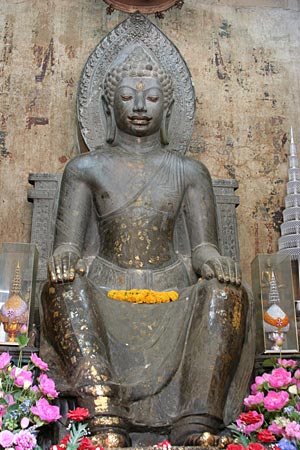
Dvaravati refers to a kingdom situated in the Chao Phraya river basin between the 7th and 11th centuries A.D. Presently Dvaravati art, including many Buddha images and sculptures, can be found at National Museum in many provinces of Central Thailand, such as Phra Pathom Chedi National Museum, Nakhon Pathom, U Thong National Museum (Suphan Buri), Prachinburi National Museum. All the above mentioned National Museums are certainly worth a visit.
The Dvaravati style derived from Indian archetypes such as Amaravati and Gupta styles, and were integrated with local art.
Dvaravati art and images went roughly through three stages : In the initial stage, there was heave Indian influence, later on the art became more independent locally, and still later influence of Khmer art is visible.
So, initially the faces depicted would resemble Indian sculptures. Later on, influenced by local styles, the aureole would appear in a lotus bud shape or orb over the cranial protuberance. Large hair curls are visible, and the eyebrows would resemble a crows wings curve, like a flying bird. Protuding eyes, with flat nose and thick lips are common. Standing Buddha images performing the Vitarka (Preaching) posture, with robes hanging to mid shin level (see example). In sitting images, a short mantle is placed over the left shoulder.
Khmer influence became visible later on with a more square face and cleft chin.
The Dharmachakra wheel (see picture at bottom) is very typical of Dvaravati art. The wheel was likely positioned on large pillars at places of worship. The Dharmachakra wheel symbolizes the Buddha's turning of the Wheel of Truth or Law. Often the Dharmachakra has eight spokes, symbolizing the eight-fold Noble Path.
The Buddha is known as the Wheel-Turner : the One who sets the cycle of teachings in motion and in consequence changes the course of destiny.
It is worth remembering that during the early centuries of Buddhism, no sculptures of the Buddha were made, and the Buddha was represented by various symbols such as the Dharmachakra, the Bodi Tree, the Buddha's footprints etc.
Imparting Fearlessness (Reassurance). This gesture is made with the hand raised and the palm facing outwards, fingers extended pointing upward. The wrist is bent at a right angle with the forearm. The gesture is sometimes made with both hands. Sometimes the Abhaya Mudra is made with one hand, while another Mudra (such as Varuda Mudra) is made with the other hand. The Buddha may be either standing, sitting or walking.
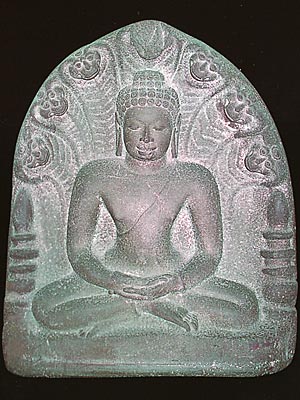
Found at Si Mahosot, Prachinburi province.
Now in the National Museum, Bangkok.

Found at Si Mahosot.
Now present at National Museum, Prachinburi.
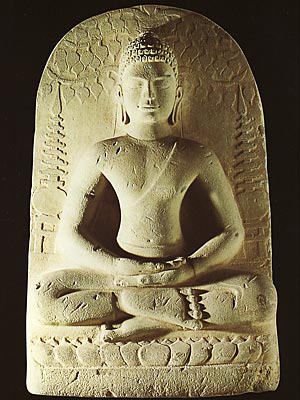
8 - 10th century A.D.
Found at Si Mahosot, Prachinburi province.
Now present at National Museum, Prachinburi.
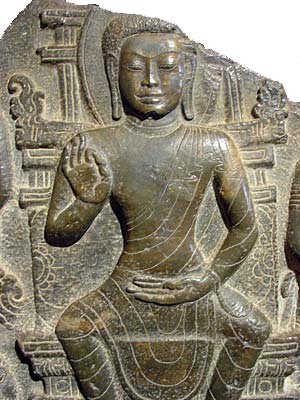
Phra Pathom Chedi National Museum (Nakhon Pathom)
Original found at Wat Sai, Nakhon Pathom

7 - 11th century A.D.
Found at Nakhon Pathom.
Now present at Phra Pathom Chedi National Museum, Nakhon Pathom.
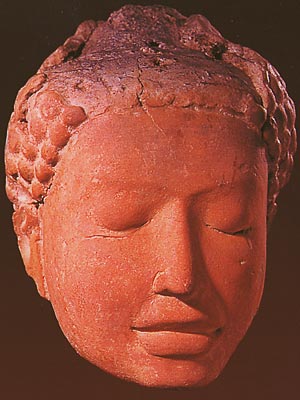
17 cm high Terracotta image.
Found at Wat Phra Ngam, Nakhon Pathom.
Now present National Museum, Bangkok.
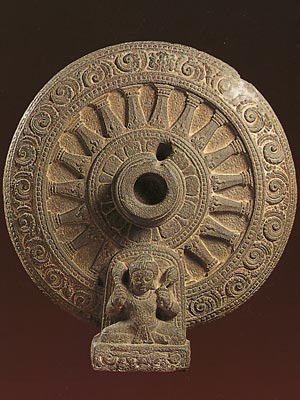
7- 11th century A.D.
Found at Nakhon Pathom.
![]() Characteristics and Postures of the Buddha
Characteristics and Postures of the Buddha
![]() Sitting Buddhas
Sitting Buddhas
![]() Reclining Buddhas
Reclining Buddhas
![]() Seven Days of the Buddha
Seven Days of the Buddha
Hand Gestures :
![]() The Six Main Mudras
The Six Main Mudras
![]() Dhyana Mudra
Dhyana Mudra
![]() Bhumisparsha Mudra
Bhumisparsha Mudra
![]() Abhaya Mudra
Abhaya Mudra
![]() Vitarka Mudra
Vitarka Mudra
![]() Varada Mudra
Varada Mudra
Historical Periods :
![]() Dvaravati
Dvaravati
![]() Khmer-Lopburi
Khmer-Lopburi
![]() Chiang Saen - Lanna
Chiang Saen - Lanna
![]() Sukhothai
Sukhothai
![]() U Thong
U Thong
![]() Ayutthaya
Ayutthaya
Historical Notes :
![]() Dvaravati
Dvaravati
![]() Sukhothai
Sukhothai
![]() Ayutthaya
Ayutthaya
![]() Resources
Resources
Temples in Thailand :
![]() Overview
Overview
![]() Wat Pho
Wat Pho
![]() Wat Benchamabophit
Wat Benchamabophit
Buddha Images at :
![]() Buddha Images at Wat Phra Pathom Chedi
Buddha Images at Wat Phra Pathom Chedi
![]() Introduction to Buddhism in Thailand
Introduction to Buddhism in Thailand
![]() The 10 Jatakas (lives of the Buddha) as depicted in Thai mural Temple paintings
The 10 Jatakas (lives of the Buddha) as depicted in Thai mural Temple paintings
More about Thailand at ThaiWebsites.com : Articles, and Web Directory
Content by Guido Vanhaleweyk, Bangkok.

.png)